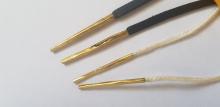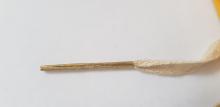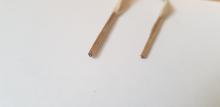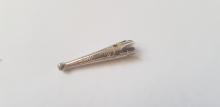The aglets discussed here are being classified using the basis of the system from Oakley (St Peter's Street Northhampton, July 1979, pp 262-263). Oakely uses the term tags instead of aglets, and excerpts from the archeological monograph are included below in italics.
Type 1 tags (Cu281 and 254) are made from a piece of sheet just wide enough to roll tightly around the end of the lace without overlapping. Near the open end, where the lace entered, a small transverse hole carries a tiny rivet, usually copper alloy but occasionally iron. Two examples have two rivets (Cu268 and 278). Type 1 tags are carefully finished with free end rounded off neatly and rough edges at top and bottom removed by small cut chamfers. Length ranges from 14 to 44mm.
Some examples of type 1 aglets I have made can be seen here:
I don't use separate types to differentiate between type 1 aglets with butted edges vs overlapping edges (I think the overlapping happens when the cord compresses more than you expected, and you still want a well crimped on aglet), or between ones with pins and ones without.
Type 2 tags (Cu288) are made from a wider piece of thiner sheet folded twice from each edge towards the centre. The lace is securely gripped by both sides of the tag all along its length with no need for a rivet. Length ranges from 22 to 39mm.
An example of a type 2 aglet I have made, showing the back of the aglet where you can see the folded in seam.
The end view of a type two aglet clearly shows the folded in crimping of the metal.
Interestingly, Oakely goes on to note (emphasis added):
The seven type 2 tags include six stratified in mid-16th to 17th century deposits. All of the earlier tags are type 1. Three tags pre-date the 15th century; 18 come from 15th century contexts; nine from 16th-17th century deposits; nine are undated.
While this is only the evidence from one archeological dig, it has me wondering if type 2 aglets show up from the mid-16th century because of a some other change; possibly the use of flat woven laces (tape or ribbon, if you prefer) on clothing? The type 2 aglets wouldn't work well with round or square profile cord (because of the way the crimp works) but they hold very strongly onto flat cords; and a rivet through a flat cord might not hold as well as it does when through leather. More investigation is required...
I also use the term Type 3 aglets in my writeups, to describe those which are much more ornate, presumably purely decorative, and which I suspect were made by jewellers rather than agletters. Some authors have a much more elaborate classification system, as they are trying to cover a wider range of things-to-go-on-the-end-of-cords.
For comparison, here's a modern, commercially available aglet. You can see from the shape that it's designed to have a cord inserted into the wide end of the cone, and the tabs are then crimped down onto the cord and/or the aglet is sewn onto the cord.



